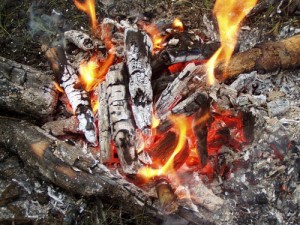 How many ways can you build a campfire? About as many ways as you can cook using them. I’ll describe some traditional ways to build a fire and perhaps a few that may be new to you. There are generally two parts to firecraft: 1) The creation of a flame. 2)Sustaining the flame as a fire. Building a fire by constructing a campfire is the focus of this text.
How many ways can you build a campfire? About as many ways as you can cook using them. I’ll describe some traditional ways to build a fire and perhaps a few that may be new to you. There are generally two parts to firecraft: 1) The creation of a flame. 2)Sustaining the flame as a fire. Building a fire by constructing a campfire is the focus of this text.
The common thread leading to sustained combustion is the progression of thin-to-thick flammable material. The three basic categories of material is referred to as tinder, kindling, and fuel. For instance, tinder might be dry grass, leaves, bark or twigs, kindling might be pencil sizes branches, and fuel might be arm sized branches or larger logs. Because heat rises along with the flames, these materials generally are stacked with the tinder at the bottom, kindling above it, and fuel beside it or placed on top of the fire once it is established. The materials should be close enough to transfer heat but loose enough to allow air flow.
Safety measures should be taken when building a fire and I always advocate having an open container of water close by. In addition, there are various ways to contain and control the fire such as by using a fire pit, trench, or Dakota hole. In environments where there is snow or soggy ground, a fire may need to be insulated from beneath using green logs as a base. When fire is needed on a deck or floor, a thick earthen pad can be used.
The campfire constructions (or fire-lays) that follow are geared toward naturally found materials that you might find in the woods. Although the larger fuel logs shown in the illustrations have been cut or split, it is not necessary for a successful campfire. Although each campfire style may share similarities they can also differ in their advantages and disadvantages.
|
|
|
| LOG CABIN – The log cabin configuration is a classic structure and very picturesque. It allows air flow and elevates kindling above the initial flames of the tinder placed within the structure. I may be helpful to dig a slight trough under one side with which to accommodate the lighting of the tinder. | |
|
|
|
| TEEPEE – The cone shape of this campfire takes advantage of the rising heat produced from the lit kindling located inside at it’s base. Like a teepee, an initial tripod of sticks with interlocking branches can be placed to support additional sticks that are leaned against it. Some of the sticks may need stability that can be gained by pressing the bottom ends into the ground. At some point this structure will collapse but will hopefully provide the critical mass required to ignite fuel sized branches that are subsequently placed on top of it. | |
|
|
|
| LEAN-TO – The lean-to is built with a log (or dry stone) as a prop to hold up kindling that is leaned against it. Underneath the kindling is placed tinder. This is my preferred method for several reasons: it is very stable structure; the fuel log can act as a wind break or wind scoop; the fuel log is immediately heated for quicker ignition. | |
|
|
|
| STAR – This is another classic campfire that works quite well. Fuel logs are placed like spokes in a wheel, leaving an opening at the center for a mound of tinder and kindling. The logs provide the same benefit as a lean-to with the added advantage that the logs can vary in length but can be pushed into the center as they are consumed. This comes in handy when you are unable to cut the fuel logs into shorter convenient lengths. | |
|
|
|
| INVERSE – In recent years there’s been attention given to the inverse campfire. This breaks the rule of using thin-to-thick materials that start from the bottom, but rather is constructed with the fuel logs at the bottom with kindling and tinder placed above. When the tinder is lit, gravity takes hold and the fire and embers descend onto the fuel below, igniting each consecutive layer as it grows. | |
|
|
|
| BUNDLE-UP – This is a name that I have attached to a variation of the Swedish Log Candle. The Swedish Log Candle is a fire log that is split or cut lengthwise into wedges, using an axe or chain saw in the process. The bundle-up can be made without tools using broken pieces of wood that are wrapped together with vines, cordage or wire. Longer pieces can be placed on the outside with shorter ones in the center. This creates a slight bowl area into which a mound of kindling and tinder is placed and lit. This aspect resembles the inverse fire structure. The advantage of the bundle-up is that it raises the fire off the ground and can be used in watery areas. Binding the bundle low allows for the longest burn time from above. | |
|
|
|
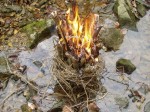
I’m sure there are other campfire methods that exist but these methods have been proven and provide options for you to use in various conditions. I’m always interested in learning new ways to build campfires and invite you to share yours.
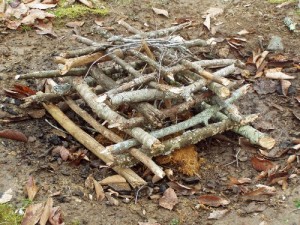
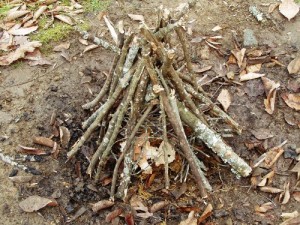
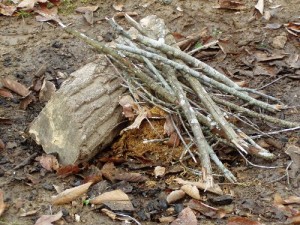
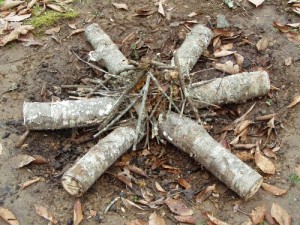
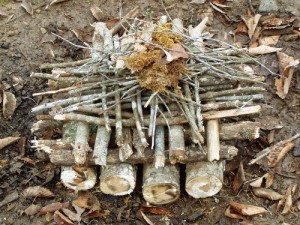
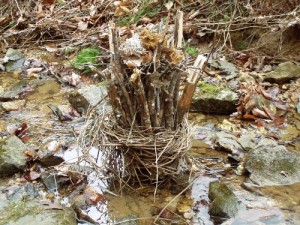



Thank you so much for this article! I really like the pictures – a real aid to someone inexperienced. That bundle-up one is seriously neat.